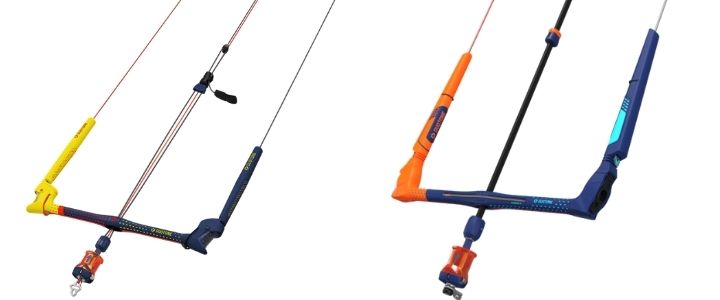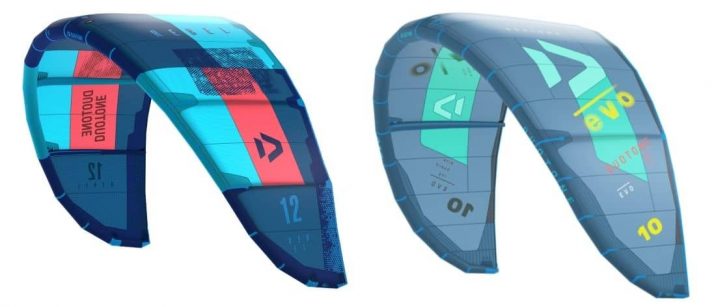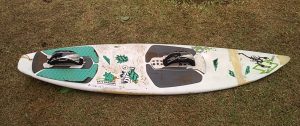The Rebel and the Evo. Both have been around for years and remain two of Duotone’s most popular kites. Which one is the best choice for you?
The Evo is a great all-around kite, responsive, easy to fly, sharp turning, and beginner friendly. It has good low-end and performs quite well for most types of riding, from freeride to waves to loops. The Rebel generates more power and is a recognized big air kite.
The Rebel is best-suited for advanced riders looking to boost very high and far, as well as for heavier riders who need extra power. The Evo is a popular beginner option as well as a capable freeride and drifting kite.
Construction
The Duotone Evo is a three-strut hybrid delta hybrid kite with a medium aspect ratio. The kite has a smooth profile. The 8m kite weighs 2.80 kg (6.2 lbs). The new version now has a fixed bridle replacing the old pulley system.
The Rebel is a five-strut hybrid delta kite with a medium aspect ratio. The 8m kite weighs 3.05 kg. The latest edition has a reduced leading edge diameter for speed and a flattened canopy profile for power.
The Evo has an open central canopy and reinforced wingtips whereas the rebel has struts evenly spread across the canopy.
Power & wind range
Low end
The Evo has a better low end compared to the Rebel and works well in the lightest wind. The Rebel, on the other hand, requires more wind to have fun.
Loading
The Evo flies best when sheeted in more, whereas the Rebel flies very smoothly when with a significant amount of trim – it will tend to backstall under excessive loading. The Evo generally has a better response when powered up and loaded.
As a result, the Evo allows you to edge harder than the Rebel, which prefers a lighter edge.
Bar pressure
The bar pressure on the Rebel is very soft including when overpowered. As a result, the kite is easy to control in stronger winds.
The Evo is very responsive in the upper range but also keeps a decently low bar pressure, offering a pleasant experience. The 12m Evo, however, has noticeably stronger bar pressure in higher winds.
Stability & turns
The Evo is a more responsive kite with better steering and maneuverability. The arc of the Evo is tighter and more pivotal. The kite turns well and responds to the slightest movements of the rider.
The Evo on soft mode allows for pivot style turns while the Rebel only allows for full turns even when tight.
The Evo sits deeper in the window and has a quicker response compared to the Rebel. However, with the Evo you need to move the kite more than with the Rebel which is more of a park and ride kite.
Jumps & tricks
When it comes to boost and hang time, the Rebel is clear winner. The Rebel is all about kite power. The kite gives you tons of control, allowing you to boost higher and fly longer and farther confidently.
The Rebel also has a specific and precise feel for new school tricks, back and front rolls, dark slides etc.
The Evo, although not as powerful, is also a fun kite for big boosted jumps. It has a long floaty hang time and also works great for font rolls. Jumps on the Evo depend more on load and pop than on sheer kite power.
Riders often agree one of Evo’s strengths is its nice looping capabilities, considered better than the Rebel. The Evo gives you better control your kite loop by adjusting your steering input. The Rebel, in contrast, makes for larger gruntier loops.
Some riders, though, rave about the smoothness and even power of kite loops on the Rebel.
Waves & foiling
The Evo is generally considered a better wave kite compared to the Rebel, with much better drifting ability.
Because of the Rebel’s tendency to backstall or back down, riding waves with the Rebel requires being seriously powered up or flying the kite in a very active way.
The Evo doesn’t need nearly as much kite moving in the waves as it drifts better, tends to sit in the center of the window, and can fly well with less line tension. The Rebel, in contrast, sits at the front of the window.
Another aspect of the Rebel that makes it less suitable than the Evo for wave riding is its lower responsiveness and slower kite loops for sharp carving turns.
The strong pull and grunt of the Rebel also makes it less ideal than the Evo for strapless riding. The Evo also generally has the upper hand for foiling in light winds.
Relaunch
The Rebel can be harder to relaunch in light wind especially when used with a 4-line bar – relaunch ability is noticeably better with 5 lines – although that comes with other drawbacks.
The Evo is well-known for its smooth and easy relaunch with minimal effort including in relatively light winds. This is one of the aspects that make it a great beginner kite as well.
Control bar, inflate system

Both the Rebel and Evo feature Duotone’s Max Flow inflation valve system which doesn’t require any adaptors. The valve features a twist lock that helps keep the kite in place while pumping. Deflation is easy through a dump valve on the side.
Duotone offers two different bars , Trust Bar and Click Bar. The Trust Bar is a standard kite bar with a depower option on the centerline above it. The Click bar has an innovative button mechanism for adjust the trim.
Both bars come stock with a high V, and a choice of four different chicken loops including bigger ones for unhooked riding or smaller ones for big air.



